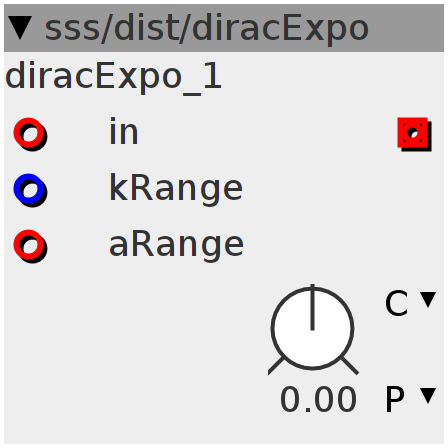diracExpo
nonlinear shaper. Outcoming waveforms have a lot in common with their analogue counterparts. code makes an exponential and inverse exponential copy of the signal. the difference between the newest and previous sample is used to mix either from original to exponential or from original to inverse exponential, depending on the sign of the difference. Range-control is bipolar, so the exponential and inverted exponential shaping process can be switch between before-peak or after-peak.
Inlets
frac32buffer in
frac32buffer aRange
frac32 kRange
Outlets
frac32buffer out
Parameters
frac32.s.map range
Declaration
int32_t diff;
int32_t prev;
int32_t pdiff;
int32_t ndiff;
int32_t positive;
int32_t negative;
int32_t mix;
int32_t norm;
int32_t val;
Audio Rate
val = val + ((inlet_in - val) >> 1);
int32_t range = __SSAT(param_range + inlet_kRange + inlet_aRange, 28);
diff = ___SMMUL(__SSAT((val - prev), 24) << 7, range << 4);
pdiff = diff > 0 ? diff : 0;
ndiff = diff < 0 ? -diff : 0;
pdiff = pdiff > (1 << 27) ? (1 << 27) : pdiff;
ndiff = ndiff > (1 << 27) ? (1 << 27) : ndiff;
positive = (inlet_in >> 1) + (1 << 26);
negative = (inlet_in >> 1) - (1 << 26);
positive = ___SMMUL(positive << 3, positive << 2);
positive = ___SMMUL(positive << 3, positive << 2);
positive = ___SMMUL(positive << 3, positive << 2) - (1 << 26);
negative = ___SMMUL(negative << 3, negative << 2);
negative = ___SMMUL(negative << 3, negative << 2);
negative = (1 << 27) - ___SMMUL(negative << 3, negative << 2) - (1 << 26);
norm = (1 << 27) - pdiff - ndiff;
mix = ___SMMUL(norm << 2, inlet_in << 2) + ___SMMUL(pdiff << 3, negative << 2) +
___SMMUL(ndiff << 3, positive << 2);
outlet_out = mix;
// outlet_out=negative;
prev = val;